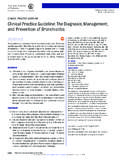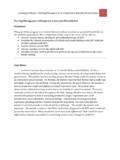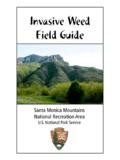Transcription of Vaccination Schedule for Children and Adolescents …
1 Vaccination Schedule for Children and Adolescents in Brazil Ot vio Augusto Leite Cintra1. IntroductionVaccination is one of the most effective actions in preventive medicine, whether in collective medicine or even at individual level. There is a rapid increase in the prevention of diseases through Vaccination . Health professionals must always be up-to-date as immunization schedules are often modifi ed. All health professionals must know which vaccines are to be recommended. Even more importantly, a vaccine should not be omitted without a sound scientifi c foundation. When speaking about prevention of disease, always remember that this is an important part of the appointment, and the physician should spend some time talking about vaccines, as they are indicated in all age present article will briefl y discuss the most relevant aspects of the Vaccination schedules of the Brazilian Society of Pediatrics and the Brazilian Society of Immunizations to help you when talking to your patients about SchedulesThe Vaccination schedules are general recommendations for the use of vaccines, based on the rationale of each vaccine, and there can be variations between different institutions and countries.
2 It should be stressed that the Schedule can be modified according to specific needs, and a specialist can help in establishing individualized schedules. Tables 1 and 2 present a summary of the Vaccination schedules of the Brazilian Society of 1. Vaccination Schedule up to 15 years of Society of ImmunizationsAge VaccineObservationsBirthHBV + BCGid2 monthsDTaP + Hib + HBV + IPV + PnC7V + RotavirusDTaP or DTP, IPV or OPV Hexavalent3 monthsMnCC4 monthsDTaP + Hib + IPV + PnC7V + RotavirusDTaP or DTP; IPV or OPVP entavalent5 monthsMnCC6 monthsDTaP + Hib+ HBV + IPV + PnC7V + InfluenzaDTaP or DTP; IPV or OPVH exavalent7 monthsInfluenza + MnCC (1)9 monthsYellow feverBooster every 10 years35 VI IAPO MANUAL OF PEDIATRIC OTORHINOLARYNGOLOGY 12 monthsSCR (MMR) + Varicella (2) + HAV15 monthsDTaP + Hib + IPV + PnC7V + MnC DTaP or DTP.
3 IPV or OPVP entavalent18 monthsHAV5 yearsDTaP + SCR + Varicella (2)9 yearsHPV3 doses with a 2 months interval between the 1st and the 2nd dose and 4 months between the 2nd and the 3rd dose15 yearsDTaPNational Immunization DayOPVS tart after 6 months of ageTable 2. Vaccine abbreviations AbreviationVaccine AvailabilityPublic Vaccination clinicsPrivate Vaccination clinics BCGidIntradermal tuberculosis vaccineYesYesHBVH epatitis B vaccineYesYesDTPT riple bacterial vaccine Diphtheria, Tetanus and Pertussis whole cellYe sYe sDTaPTriple bacterial vaccine Diphtheria, Tetanus and Pertussis acellular (isolated B. pertussis antigens)No(CRIE)Ye sHibConjugate vaccine Haemophilus influenzae type bYe sYe sPnC7 VPneumococcal conjugate vaccine with 7 serotypesNo(CRIE)Ye sMcCCMeningococcal group C conjugate vaccine No(CRIE)Ye sOPVA ttenuated oral polio vaccineYesYesIPVI nactivated injectable polio vaccineNo(CRIE)Ye sMMRV iral triple vaccine measles, mumps, and rubella Ye sYe sHAVH epatitis A vaccine No(CRIE)Ye sdtapTriple bacterial vaccine Diphtheria, Tetanus and Pertussis acellular (isolated B.)
4 Pertussis antigens))NoYes36VI IAPO MANUAL OF PEDIATRIC OTORHINOLARYNGOLOGY HexavalentCombined hexavalent vaccine DTaP + Hib + IPV + Hepatitis BNoYesPentavalent Combined pentavalent vaccine DtaP + Hib + IPVNoYesTetravalent Combined vaccine DTP + HibYesNoHPVT etravalent vaccine against human papillomavirus serotypes 6, 11, 16 and 18 (HPV)Ye sN oObservations1. DtaP, Hib, IPV and Hepatitis B vaccines should be preferably given in their combined form (HEXA) thus eliminating the second dose of Hepatitis B vaccine with one month of age, reducing the number of The meningococcal group C conjugate vaccine (Neisseria meningitidis) can be given at two months of age. For convenience reasons, however, it is included in the Vaccination Schedule at three months. There are three products presently available:a. MnCC conjugate vaccine from Wyeth, with mutant diphtheria protein (CRM197);b.
5 MnCC conjugate vaccine from Novartis, with mutant diphtheria protein (CRM197);c. De-O-Acetylated MnCC conjugate from Baxter, with tetanic of the manufacturers vaccines can be used in two-dose schedules in the first year of age, followed by one booster dose after 12 months of age. If Vaccination is started after the child is one year old, all vaccines can be given as a single dose, according to Table 3 presented below. Each of the manufacturers vaccines can be used in two-dose schedules in the first year of age, followed by one booster dose after 12 months of age. If Vaccination is started after the child is one year old, vaccines can be given as a single dose, according to Table 3 presented 3. Vaccination Schedule according to the manufacturer:VaccineAgeDosesStarting atRouteWyeth and Novartis0 to 11 months2 + 1 booster3 months of ageIMBaxter0 to 11 months2 + 1 booster2 months of ageIMAny manufacturer> 1 year1 Single doseIMThe booster of a pneumococcal conjugate vaccine given after one year of age is essential to ensure a prolonged protection.
6 This recommendation was included in the Vaccination Schedule this year, as the consolidation of this vaccine results in the United Kingdom showed a decreased efficacy in Children after four years of age when they received only three doses of the vaccine in the first year of life. It is not recommended to delay the Vaccination after the first year of life, as the 37 VI IAPO MANUAL OF PEDIATRIC OTORHINOLARYNGOLOGY incidence of meningococcal disease in Brazil is high during this The whole-cell (DTP) and acellular (DtaP) Bordetella pertussis vaccines are presently available. They have a similar efficacy, but DtaP is associated with less reactivity and is available in the combined The oral polio vaccine (OPV) with live attenuated virus has a risk of paralysis of 1 per 750,000 to million administered doses, but this does not occur with the inactivated vaccine (IPV).
7 Besides this important advantage, IPV also requires a lower number of doses and waste is reduced. With IPV being combined with other vaccines, this option becomes more advantageous and is therefore recommended. OPV should be maintained in the National Immunization Days and can be given to all Children who received The influenza vaccine ( flu vaccine ) is recommended for all healthy Children from six to 59 months of age, as this is the age group with highest risk for more severe infections by this virus. It is recommended for other age groups to avoid an infection by this agent. The recommendation is maintained in the presence of comorbidity for those older than six months of age. A two-dose Vaccination Schedule is used in the first year of Vaccination and then in a single yearly dose, according to Table 4 presented 4. Vaccination Schedule for Influenza VirusAge VaccineNo.
8 DosesInterval Route6 to 35 ml1 - 2*1 monthIM3 to 8 ml1 - 2*1 monthIM> 9 ml1-IM(*) only in the first year of influenza The yellow fever vaccine indication depends on the epidemiological situation of the municipality/state. It can be given from nine months of age on in areas where the disease has a higher risk of All Children receiving the combined DtaP + Hib vaccine should receive a Hib booster at 15 months, and then will continue to receive the combined The minimum Vaccination Schedule against poliomyelitis, using IPV, should include 4 doses of this vaccine, and at least one of them after a year of age. In this way, at 15 months of age the Children should receive a pentavalent vaccine including DtaP + Hib + IPV. The use of OPV at 15 months of age is acceptable, but the combined vaccine is preferred.
9 All Children can receive the OPV booster doses in the Vaccination The second dose of BCGid was recently discontinued as there is no evidence that this second dose decreases the incidence of pulmonary The triple acellular vaccine for adults should be used to replace the double vaccine for adults, as it has the advantage of protecting Adolescents and adults against IAPO MANUAL OF PEDIATRIC OTORHINOLARYNGOLOGY 3. Respiratory Syncytial Virus (RSV)The prevention of severe RSV infections with immunoglobulin formed by humanized monoclonal antibodies (palivizumab) is recommended for high risk Children , such as the preterm infants, chronic pulmonary disease (bronchopulmonary dysplasia) patients and Children with hemodynamically signifi cant congenital cardiomyopathy. The main objective of this prophylaxis is to reduce the morbidity of RSV infection as evaluated by the reduction of hospitalization rates by up to 70%.
10 The use of palivizumab is limited to RSV season, and should be given monthly by IM administration, 5 doses Schedule , during the epidemic period (April/May through August/September). The present recommendation of the Brazilian Society of Pediatrics and the Brazilian Society of Immunizations follows the Table 5 presented of the Brazilian Society of Pediatrics and The Brazilian Society of ImmunizationsHighly recommended Preterm infants born with < 28 weeks GA, up to one year of age during the RSV seasonChildren with congenital cardiomyopathy up to 2 years of age who need treatment for CHFI nfants with BPD up to 2 years of age who required treatment in the 6 months preceeding RSV seasonRecommendedPreterm infants born with 28 to 32 weeks GA who are up to 6 months of age during the RSV seasonIndicatedPreterm infants born with 33 to 35 weeks GA who are up to 6 months of age during the RSV season and have 2 or more risk factors for severe RSV infectionGA: gestational ageCHF: congestive heart failureBPD.









